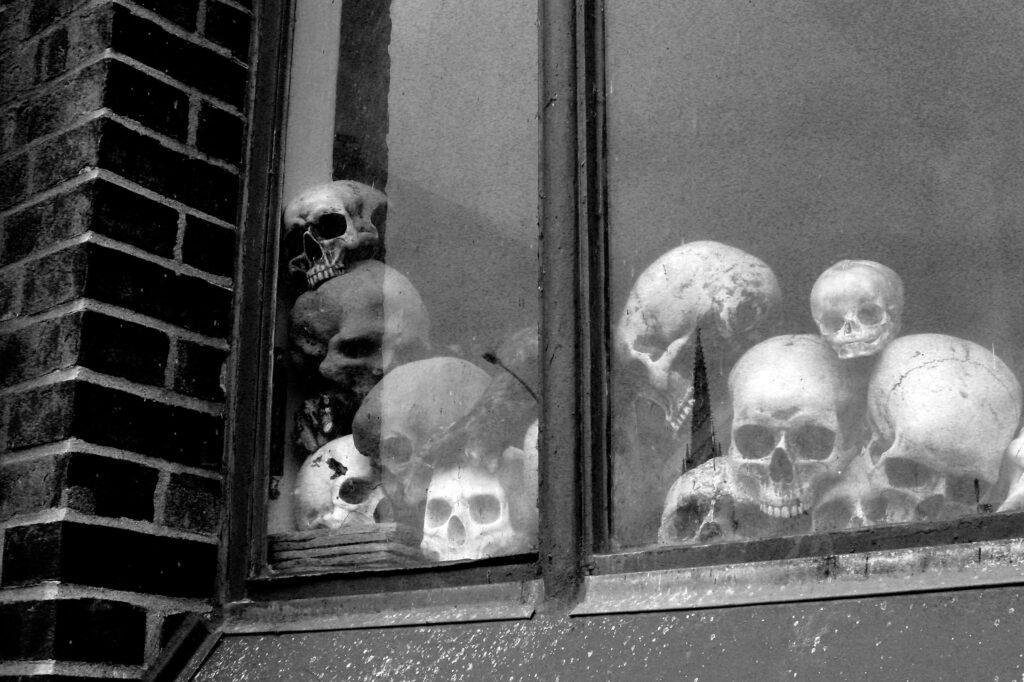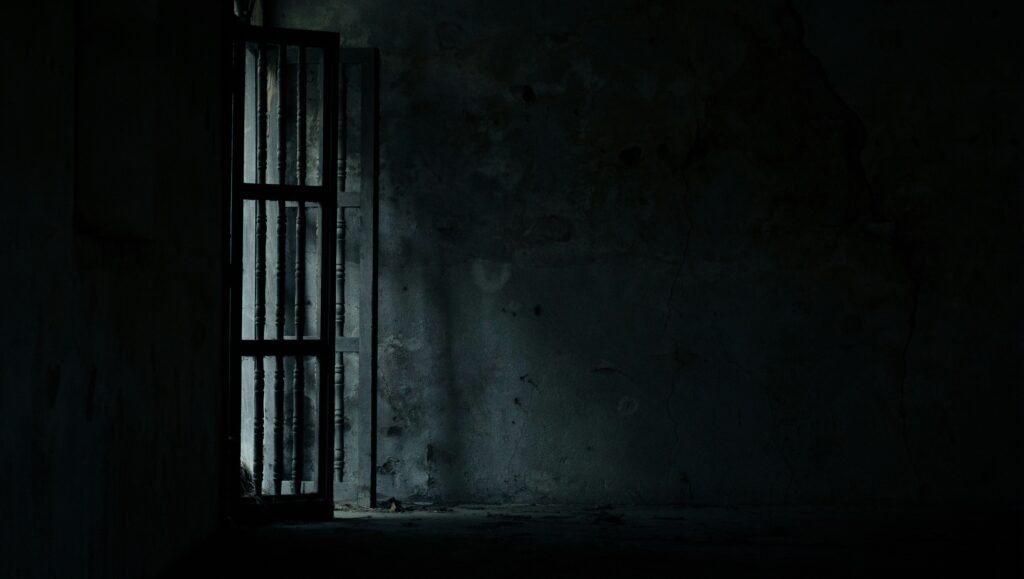When it comes to psychological horror, atmosphere is everything. From the creak of a floorboard to the weight of silence, building tension keeps readers and viewers glued to the page or screen, their hearts racing and senses on high alert.
If you’re eager to evoke existential dread in your audience but unsure how to write psychological horror, keep reading. Whether you’re writing psychological horror for a short story, novel, or script, these tips will help you create a world where terror seeps into every shadow.
1. Use the Environment as a Character
In great psychological horror, the setting isn’t just a backdrop; it’s active and menacing. Think of fog curling through empty streets, peeling wallpaper in a derelict house, or the hum of fluorescent lights in an abandoned hospital.
Describe sensory details such as sound, smell, and temperature to make your readers feel like they’re right there in your scene. Sensory details create an immersive experience, whether you’re translating them on screen or describing them on paper. It lets your audience immerse themselves in your world, waiting patiently for something to go wrong.
Some examples to get your psychological horror wheels spinning:
- Soundscapes: Footsteps echoing, distant whispers, sudden silences, sharp screeches, intense music.
- Textures: Sticky underfoot, rough plaster, oily sheen on metal, the softness of a fabric, the tickle of a feather.
- Smells: Stale air, damp wood, antiseptic sting, rank mold, sweet and herbal, metal tang.

2. Master the Art of Pacing for Building Tension
Pacing is the heartbeat of writing psychological horror. A slow build lets dread accumulate, while well‑timed breaks in action give readers a false sense of security, before you yank it away again! Don’t be afraid of light comic levity or relief, but don’t lean too far into it, either. You don’t want to entirely remove your audience from the terror and intensity of the moment.
There are a plethora of things that can build tension, for instance:
- Slow moments: Let minor oddities linger; an unlocked door, a misplaced object, an unnatural expression, a person out of place.
- Quick jolts: Short, sharp sentences when something stirs in the dark, the camera quickly pans to something unexpected, or the classic “close the door and something is right there.”
- Breathers: Calm scenes where the protagonist thinks they’re safe. These moments are effective in giving your audience a slight break, much like the calm before the storm. Relieve the tension for a moment, insert some witty dialogue for a quick laugh, and then bring the next monster promptly in!
3. Leverage Uncertainty and the Unknown
Fear of the unknown is a hallmark of psychological horror. Instead of spelling out every detail, hint at horrors lurking out of view. Use shadows, half‑heard noises, and characters’ hesitant reactions to stoke the reader’s imagination.
This can include things like:
- Unseen threats: A shape beyond vision, footsteps off‑screen, a stick cracking in the woods, unidentified whispers.
- Half‑reveals: Glimpses; a silhouette, a flash of movement, a streak of light, a figure in the peripherals, an apparition with their face covered.
- Foreshadowing: Subtle clues like odd dialogue, symbolic objects, yet unexplained clues, or puzzle pieces.
- Unreliable narrators: When even the narrator of the story can’t provide a foolproof perspective, it makes the audience question everything that’s seen, heard, and experienced. Their senses are heightened for clues, and they’re on the edge of their seat to learn the truth.
4. Deepen Character Emotions to Amplify Tension
When you’re writing psychological horror, your characters’ inner lives fuel the fear. Tap into real emotions like paranoia, guilt, and grief to make every strange event feel personal. This is where a good story can become a great one. Crafting deep, flawed, and well-developed characters is a game-changer in psychological horror.
A character’s feelings about or reaction to something can amplify the horror of even a mild situation. If you’ve successfully made your audience care about your characters and become emotionally invested in them, the bad things that happen feel even worse than if they don’t like the person.
While the first-person perspective, particularly when writing psychological horror, is common and popular for this reason, it is also possible in the third person. You’ll need to become skilled at conveying emotions through actions and crafting dialogue that reveals the necessary details.
For example:
- Internal monologue: Thoughts racing, rationalizations colliding, internal reactions, private thoughts or opinions.
- Physical reactions: Racing heart, shallow breaths, trembling hands, eyes darting, body tensing.
- Relationships: Isolation or mistrust among friends amplifies unease. Confrontations can be effective, but are best when there’s an internal buildup that makes the external reactions more dramatic and impactful.
5. Sound and Silence: An Unlikely Duo in Psychological Horror
In psychological horror, what you don’t hear can be scarier than what you do. Play with contrasts and lean into creeping, building quiet:
- Crescendo: Building ambient noise—wind, distant thunder, rain—peaking at a climactic moment.
- Drop to silence: Cut all sound before a reveal, so the next noise has a greater impact. This is what can make a traditional or perhaps predictable jump scare the most effective, even if the audience thought they saw it coming.
- Repetitive motifs: A creaking hinge or dripping tap that grows more ominous each time. Things like unknown footsteps, knocking, creeping, and tapping can slowly grow louder to create the sense that the source of the noise is slowly moving closer. This works beautifully for building tension and ultimately creates an intense resolution when the audience finally learns or sees the source of the noise.

6. Symbolism and Subtext in Psychological Horror
Layering in symbols, such as children’s toys, broken mirrors, and flickering lights, adds depth to your psychological horror and rewards attentive readers. Subtext lets you explore themes like madness or guilt without spelling everything out, keeping tension simmering beneath the surface.
Most writers have heard the advice “show, don’t tell,” which should always be taken with a grain of salt. But it is essential to convey things in different ways; if everything is simply said, there is no tension, no curiosity, no wonder.
Some examples of effective symbolism, either on screen or in print, can include:
- Objects: A creepy doll missing an eye, a cracked photograph
- Colors: Pale hues that drain warmth, sudden splashes of red
- Motifs: Recurring images that tie back to a character’s backstory
7. Cliffhangers and Chapter Hooks
If you’re writing psychological horror in chapters, end with a question or unsettling image that makes readers want to turn the page. A whispered threat, a door slowly opening, or a protagonist’s sudden realization will lock in momentum.
This not only builds tension but also makes people want to keep going. Ending a chapter by answering a question or giving a satisfying solution will halt your momentum. It creates a natural stopping point, but your goal is to keep readers hooked, on edge, and eager to continue.
Consider these when ending a chapter and starting a new page:
- Question: “Who was really standing behind her?”
- Image: “The hallway lights flickered… then went out.”
- Confession: “He wouldn’t admit what he’d done, but I heard his heartbeat.”
Write Psychological Horror That Keeps Them Looking Over Their Shoulder
Great psychological horror is all about building tension through atmosphere, pacing, and emotional depth. By treating your setting like a living threat, leveraging uncertainty, and writing with sensory precision, you’ll immerse horror fans in a world they can’t escape—even after the final line.
Ready to try your hand at writing psychological horror? Embrace the shadows, trust the silence, and let tension weave its way into every scene.
If you’re a horror fanatic and enjoy the tense, exciting adrenaline rush of deep psychological horror, don’t miss my upcoming short story collection Uncovered: The Story of Eva Courtland and Other Spooky Tales, dropping this August! Subscribe to the email newsletter for a reminder when the book launches.



0 Comments